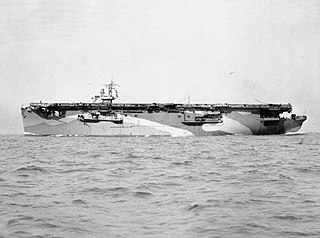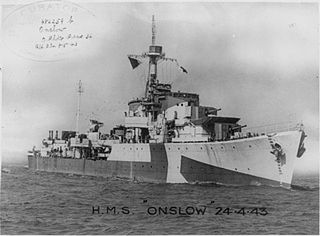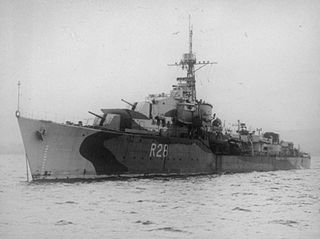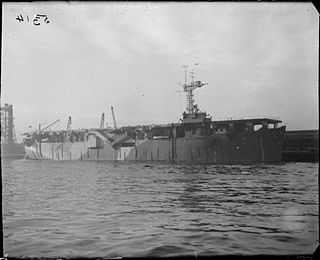
HMS Victorious was the third Illustrious-class aircraft carrier after Illustrious and Formidable. Ordered under the 1936 Naval Programme, she was laid down at the Vickers-Armstrong shipyard at Newcastle upon Tyne in 1937 and launched two years later in 1939. Her commissioning was delayed until 1941 due to the greater need for escort vessels for service in the Battle of the Atlantic.

HMS Battler (D18) was an American-built escort carrier that served with the Royal Navy during the Second World War.

HMS Attacker (D02) was an American-built escort carrier that served with the Royal Navy during the Second World War.

USS Block Island (CVE-8) was an Attacker-class escort aircraft carrier that served during World War II.

HMS Fencer (D64/R308) was an American-built Attacker-class escort carrier that served with the Royal Navy during the Second World War.

USS Hamlin (CVE-15) was one of a large group of escort aircraft carriers built on Maritime Commission C-3 hulls and transferred to the Royal Navy under Lend Lease during World War II. The ship was launched by Western Pipe and Steel Company, San Francisco, California, on 5 March 1942, as AVG-15, aircraft escort vessel. She was sponsored by Mrs. William H. Shea. Her designation was changed to ACV-15, auxiliary aircraft carrier, 20 August 1942, and she was acquired and simultaneously transferred to the United Kingdom 21 December 1942. Hamlin's designation was changed to CVE-15, escort aircraft carrier, 15 July 1943.

USS St. George (CVE-17) was laid down on 31 July 1941 as a C3-S-A2 by Ingalls Shipbuilding, Hull 296 of Pascagoula, Mississippi, under Maritime Commission contract as the (second) SS Mormacland for Moore-McCormack Lines, Inc.,. She was renamed St. George (AVG-17) by the United States Navy on 7 January 1942; and assigned to the United Kingdom under Lend-Lease as HMS Pursuer on 24 February 1942. The vessel was launched on 18 July 1942, sponsored by Mrs. Mary Ann S. Bartman. The escort carrier was reclassified ACV-17 on 20 August 1942, acquired by the US Navy and simultaneously transferred to Britain on 14 June 1943. She was reclassified CVE-17 on 15 July 1943.

The name Prince William (CVE-19) was assigned to MC hull 198, a converted C3 laid down by the Western Pipe and Steel Company, San Francisco, California, 15 December 1941.

USS Jamaica (CVE-43), was an escort carrier of World War II that served in the British Royal Navy as HMS Shah (D21). Returned to the United States at war's end, she was converted into a merchant vessel and she was sold into civilian service in 1946 as Salta. She was ultimately scrapped in 1966.

HMS Tracker (BACV-6/D24) was an Attacker-class escort carrier that was built in the United States, but served in the Royal Navy during World War II.

HMS Biter was a Royal Navy escort carrier during the Second World War. She was laid down as a merchant ship at the Sun Shipbuilding & Drydock Company yard at Chester, Pennsylvania. Laid down on 28 December 1939, she was converted to an escort carrier and commissioned in the Royal Navy on 6 May 1942. She was returned to the United States in 1945 and subsequently lent to France.

811 Naval Air Squadron was a unit of the British Royal Navy's Fleet Air Arm. It was first founded in 1933, and served during World War II, seeing action in the battle of the Atlantic and on Russian convoys, and was eventually disbanded in 1956.

HMS Searcher was a Ruler-class escort carrier of the Royal Navy. Built in Seattle as a Bogue-class, she was transferred to the United Kingdom under Lend-Lease. Launched in 1942 she served until 29 November 1945. She was sold into merchant service and renamed Captain Theo. In 1966, she was renamed again to Oriental Banker and was finally scrapped in Taiwan in 1976.

The Attacker class were a class of escort aircraft carriers in service with the British Royal Navy during the Second World War.

HMS Avenger was a Royal Navy escort aircraft carrier during the Second World War. In 1939 she was laid down as the merchant ship Rio-Hudson at the Sun Shipbuilding & Drydock Company yard in Chester, Pennsylvania. Launched on 27 November 1940, she was converted to an escort carrier and transferred under the lend lease agreement to the Royal Navy. She was commissioned on 2 March 1942.

HMS Onslow was an O-class destroyer of the Royal Navy. The O-class were intermediate destroyers, designed before the outbreak of the Second World War to meet likely demands for large number of destroyers. They had a main gun armament of four 4.7 in guns, and had a design speed of 36 kn. Onslow was ordered on 2 October 1939 and was built by John Brown & Company at their Clydebank, Glasgow shipyard, launching on 31 March 1941 and completing on 8 October 1941.

HMS Verulam was a V-class destroyer of the British Royal Navy that saw service during the Second World War.

HMS Nairana was the lead ship of the Royal Navy's Nairana-class escort carriers that saw service in the Second World War. She was built at John Brown & Company shipyards in Clydebank, Scotland. When construction started in 1941 she was intended as a merchant ship, but was completed and launched as an escort carrier, entering service at the end of 1943.

HMS Vindex (D15) was a Nairana-class escort carrier of the Royal Navy that saw service during the Second World War. She was built at Swan Hunter shipyards in Newcastle upon Tyne. When construction started in 1942 she was intended as a merchant ship, but was completed and launched as an escort carrier, entering service at the end of 1943.

The Nairana-class escort carrier was a British-built class of three escort carriers. They were constructed one each in England, Scotland and Northern Ireland to the same basic design during the Second World War for service with the Royal Navy.


















